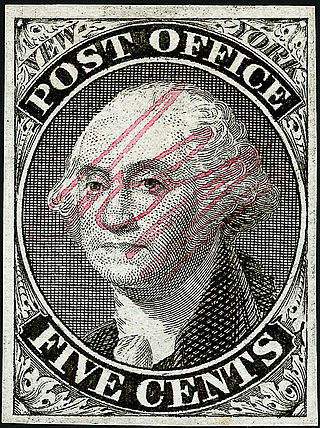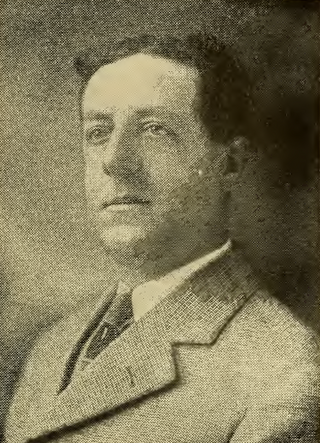Related Research Articles

Philately is the study of postage stamps and postal history. It also refers to the collection and appreciation of stamps and other philatelic products. Philately involves more than just stamp collecting or the study of postage; it is possible to be a philatelist without owning any stamps. For instance, the stamps being studied may be very rare or reside only in museums.

Postal service in the United States began with the delivery of stampless letters whose cost was borne by the receiving person, later encompassed pre-paid letters carried by private mail carriers and provisional post offices, and culminated in a system of universal prepayment that required all letters to bear nationally issued adhesive postage stamps.

Walter Augustine Brown was an American sports executive. He was the founder and original owner of the Boston Celtics, operated the Boston Garden-Arena Corporation, and served as president of the Boston Athletic Association. In ice hockey, he coached the Boston Olympics to five Eastern Hockey League championships, owned the Boston Bruins, and served as president of the International Ice Hockey Federation. He was inducted into the Hockey Hall of Fame in 1962, the Naismith Memorial Basketball Hall of Fame in 1965, and IIHF Hall of Fame in 1997.

George Vincent Brown of Hopkinton, Massachusetts, was an American sports official. He championed the development of various sports and sporting events in the United States, most notably the Boston Marathon and amateur ice hockey. From 1904 to 1936, Brown served the United States Olympic Team as a manager, official, and coach. In 1919, he became general manager of the Boston Arena, home to indoor track meets, boxing matches, and hockey games, among other events.

Arthur Hind (1856–1933), of Utica, New York, was a British-born American textile industrialist and philatelist.

United States airmail was a service class of the United States Post Office Department (USPOD) and its successor United States Postal Service (USPS) delivering air mail by aircraft flown within the United States and its possessions and territories. Letters and parcels intended for air mail service were marked as "Via Air Mail", appropriately franked, and assigned to any then existing class or sub-class of the Air Mail service.

The Roll of Distinguished Philatelists (RDP) is a philatelic award of international scale, created by the Philatelic Congress of Great Britain in 1921. The Roll consists of five pieces of parchment to which the signatories add their names.
Charles Haviland Mekeel, of St. Louis, Missouri, was a well-known stamp dealer and editor. He figured prominently in the 1895 “find” of the St. Louis Postmaster Provisionals, which solved problems related to their authenticity.
Antigua was discovered by Christopher Columbus, in 1493, and was named after the church of Santa Maria la Antigua in Seville. It was first settled in 1632. By the Treaty of Breda in 1667 it became a British Possession.
The Boston Garden-Arena Corporation was an American corporation that oversaw the operations of the Boston Garden from 1934 to 1973. It was formed when the Boston Arena Corporation gained control of the Boston Garden from the Madison Square Garden Corporation in 1934. From 1946 to 1950 it owned the Boston Celtics. In 1951 it purchased controlling interest in the Boston Bruins from Weston Adams. In 1953 it sold the Boston Arena to Samuel M. Pinsly for $398,000. In 1973, the Boston Garden-Arena Corporation merged with Storer Broadcasting.

The St. Louis Bears are a set of Provisional stamps issued by the St. Louis Post office in 1845-46 to facilitate prepayment of postal fees at a time when the United States Post Office had not yet issued postage stamps for national use. St. Louis, whose postmaster, John M. Wimer, instigated the production, was one of eleven cities to produce such stamps. Bears were offered in three denominations: 5¢, 10¢ and 20¢; the earliest known postmark date on a stamp of the issue is November 13, 1845.

The Alexandria "Blue Boy" is a very rare stamp. It takes its name from the feature that makes it unique: its color. One of the few surviving stamps from a rare issue—the Postmaster's Provisionals produced in Alexandria, D.C., beginning in 1846, only seven of which are known—the Blue Boy is the sole example printed on blue paper. Postally used, the Blue Boy remains affixed to its original envelope, which last sold in 2019 and still holds the record for the highest priced cover of United States philately.

The New York Postmaster's Provisional is, as its designation implies, a postage stamp provided by the New York Post Office to facilitate the prepayment of mail at a time when the United States had not yet issued postage stamps for national use. Placed on sale on July 14, 1845, this was the nation's first provisional stamp to be issued by a local post office in response to the congressional postal reform act that had taken effect two weeks earlier. That law, passed on March 3, 1845, standardized nationwide mail rates, with the result that the use of stamps became a practical and reliable method of postal prepayment. Before standardization, the many different postal rates in different jurisdictions had made fees too unpredictable to prepay all letters with stamps as a matter of course, with the result that recipients of letters—rather than senders—generally paid the postage on them. Baltimore announced the issue of a provisional stamp one day after New York, on July 15, and New Haven soon followed. The New York issue has been cited as "the most elegantly executed and widely used of the group of provisionals issued by eleven different [U. S. post] offices between 1845 and 1847."
Abraham Hatfield was an American businessman, philanthropist, and philatelist who signed the Roll of Distinguished Philatelists in 1925. He was "an early plater of the 5¢ New York."
Thomas J. Kanaly was an American sports executive with the Boston Athletic Association and the Boston Garden-Arena Corporation.
Raymond White Lapham was an American businessman and philanthropist who served as president of the Boston Garden-Arena Corporation.

Daniel Henry Coakley was an American Democratic politician and attorney from Massachusetts. He was a key figure in early 20th century Boston politics, as an ally District Attorney Joseph C. Pelletier and as an on-again-off-again ally to Mayor James Michael Curley. As an attorney, he took part in numerous badger game extortion schemes and was disbarred in 1922 for deceit, malpractice, and gross misconduct.

James G. Moran was an American politician who served as President of the Massachusetts Senate from 1935 to 1936.
John Russell Macomber was an American financer and sportsman.
References
- 1 2 3 4 5 Bierman, Stanley, M., M.D. (1988). "Henry G. Lapham: United States Primitives Extraordinaire" (PDF). U.S Philatelic Classics Society. 40 (4): 6. Retrieved 7 July 2018.
- 1 2 3 4 5 6 7 8 9 10 "Henry G. Lapham, Noted Promoter of Sports Events, Dies". The Boston Daily Globe. December 17, 1939.
- 1 2 "Henry G. Lapham". The Wall Street Journal. October 20, 1926.
- ↑ "Homes Renews Fight Against "Lapham Group"". The Boston Daily Globe. October 17, 1924.
- ↑ "Present Lapham with Set of Clubs". The Boston Daily Globe. October 17, 1924.
- ↑ "Wightman Chosen B.A.A. President". The Boston Daily Globe. April 28, 1926.
- ↑ Hurwitz, Hy (September 7, 1934). "Garden-Arena Plan Adopted". The Boston Daily Globe.
- ↑ "Boston Garden Is On Its Own". The Boston Daily Globe. November 8, 1936.
- ↑ "Lapham is Elected to Head N.A.A.B.P". The New York Times. March 30, 1920.
- ↑ "Tennis Body in Olympics". The Boston Daily Globe. November 23, 1922.
- ↑ "Lapham to Resign from Olympic Committee". The Boston Daily Globe. September 27, 1927.
- ↑ "MacArthur Chosen U.S. Olympic Head". The New York Times. September 18, 1927.
- ↑ "Schiavone Held For Letter to Lapham". The Boston Daily Globe. May 20, 1932.
- ↑ "Guard Mrs. Lapham From Kidnapers". The Boston Daily Globe. February 15, 1934.
- ↑ "Mrs. Rebecca Lapham". The Boston Daily Globe. April 9, 1940.